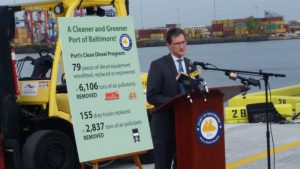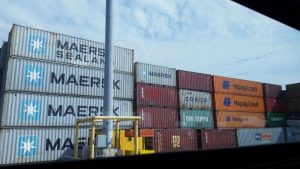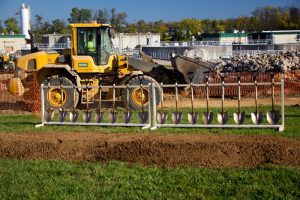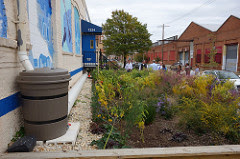eMDE – Clean & Green Ports and more
THE LATEST FROM THE MARYLAND DEPARTMENT OF THE ENVIRONMENT
Clean & Green Ports partnership continues to grow
Funding awarded to Maryland Port Administration to revamp locomotives and cargo equipment to further clean air
The Clean and Green Ports agreement has been responsible for significant air quality improvements in the area of the Port of Baltimore, one of the nation’s busiest ports.
Last year, MDE signed a Memorandum of Understanding with the Maryland Department of Transportation and Maryland Port Administration and $870,000 was awarded to replace 26 dray trucks coming in and out of the port with newer, cleaner trucks with lower emissions.
 On Oct.20, MDE Secretary Ben Grumbles participated in another event at the Dundalk port to celebrate round two of the Clean and Green Ports agreement with a press conference and tour.
On Oct.20, MDE Secretary Ben Grumbles participated in another event at the Dundalk port to celebrate round two of the Clean and Green Ports agreement with a press conference and tour.
EPA awarded about $1 million in funding to the Maryland Port Administration. This funding is being made available for the installation of idle reduction technology on five locomotives and the repowering/replacement of cargo handling equipment that operates at the port with newer, cleaner and more efficient equipment. The funding comes from the federal government’s Diesel Emissions Reduction Act as part of the Energy Policy Act of 2005.
The project is anticipated to reduce ozone precursors like nitrogen oxides and hydrocarbons by a total of about 250 tons. The metropolitan Baltimore area currently is meeting the U.S. Environmental Protection Agency’s 2008 health-based standard for ground level ozone but a more stringent standard was adopted last year. Because of that, it is important to identify other ozone reductions that can be made with targeted programs.
“Our partnership with the port, the Maryland Department of Transportation and local community groups has been a major success in helping further clean the air around the port and across the Baltimore area. By working in partnership, we’ve been able to prioritize clean air initiatives, secure funding for those efforts and implement major emission reduction projects,” said George “Tad” Aburn, director of the MDE Air and Radiation Management Administration.
“With the almost $2 million invested over the last two years, the air is cleaner and public health is better protected. And this is just the beginning. We have plans to continue the progress for years to come,” Aburn said. “This effort is also important because of the port’s role as an economic engine for the state. A clean, thriving port helps bring jobs to the state while also continuing the clean air progress Maryland has made in recent years.”
The Port of Baltimore supports more than 13,600 direct jobs and nearly 130,000 jobs in Maryland are linked to the port.
 Tim Shepherd, who oversees technical aspects of MDE’s Mobile Sources Control Program, said a number of other projects to reduce emissions are planned for the future by the agency.
Tim Shepherd, who oversees technical aspects of MDE’s Mobile Sources Control Program, said a number of other projects to reduce emissions are planned for the future by the agency.
One of those projects, which possibly could use funding from Maryland’s part of the national Volkswagen diesel vehicle settlement, would reduce emissions from the engines of forklifts, tractors, locomotives, on-road trucks, and cranes operating at the port. In addition to these projects, other projects that could be funded include replacement of conventional fuel vehicles with alternative fuels such as compressed natural gas or electricity, Shepherd said.
The Maryland Port Administration also is investigating increased energy efficiency by using radio frequency identification tags for tracking trucks onsite. Consideration of an earlier investigation into exhaust capture technology for vessels has been tabled, Shepherd said.
IN THE NEWS
Baltimore Sun Op-Ed: Md. takes a smart approach on septics
Environmental economics research professor writes: Even though advanced septic pollution controls are highly effective at removing nitrogen, for many locations, the nitrogen removed would never have reached a place where it could do harm. With flexibility, local governments will have the option to spend money in ways that will most meaningfully improve water quality.
Herald-Mail: Officials break ground on upgrades to Washington County sewage plant

Photos courtesy of Washington County
 The same day as the 44th anniversary of the national Clean Water Act, Maryland Secretary of the Environment Ben Grumbles said Washington County continues to prove itself as an environmental leader – locally, regionally and beyond.
The same day as the 44th anniversary of the national Clean Water Act, Maryland Secretary of the Environment Ben Grumbles said Washington County continues to prove itself as an environmental leader – locally, regionally and beyond.
WMAR-TV: Could a new grant help to improve Baltimore’s sewer issues?
The city of Baltimore is getting a little help when it comes to its sewer issues — $20 million to be exact. The grant comes from the state of Maryland to help prevent sewer overflows throughout the city and improve infrastructure in the Patapsco and Herring Run sewer sheds.
AIR, LAND, WATER – DID YOU KNOW?
Lead poisoning cases remain low but testing and prevention must increase

Photo by Eelke Dekker, courtesty of Creative Commons license
A new Maryland Department of the Environment report shows that childhood lead poisoning in Maryland remains near record-low levels. However, the 2015 Childhood Blood Lead Surveillance report also finds that the number of children tested for the disease has stagnated in recent years and that the number of lead poisoning cases increased in areas of the state where testing was not mandated – underscoring the importance of the state’s new lead testing plan.
Maryland counties meet funding requirements to reduce stormwater pollution
Maryland’s largest jurisdictions have met their requirements under state law to develop financing plans to reduce polluted stormwater runoff and protect and restore local waters and the Chesapeake Bay.
 A review by the Maryland Department of the Environment determined that Baltimore City and the state’s largest counties dedicated funding for clean water projects as required under Maryland’s Watershed Protection and Restoration Program. That program was revised under a bill, signed into law by Governor Larry Hogan in 2015, that repealed a mandate that forced local jurisdictions to collect a stormwater remediation fee and instead gave them the flexibility to enact a plan that best fit their individual situation. The total projected investment for stormwater reduction projects for Maryland’s largest jurisdictions is more than $1 billion over five years.
A review by the Maryland Department of the Environment determined that Baltimore City and the state’s largest counties dedicated funding for clean water projects as required under Maryland’s Watershed Protection and Restoration Program. That program was revised under a bill, signed into law by Governor Larry Hogan in 2015, that repealed a mandate that forced local jurisdictions to collect a stormwater remediation fee and instead gave them the flexibility to enact a plan that best fit their individual situation. The total projected investment for stormwater reduction projects for Maryland’s largest jurisdictions is more than $1 billion over five years.
Power company to pay $1 million penalty, perform $1 million in environmental projects, upgrade water pollution-prevention technology
A company that operates power plants accused of violating permits and polluting the Potomac and Patuxent Rivers will pay a $1 million penalty and take steps to protect and restore the environment under an agreement filed in federal court. NRG Chalk Point, LLC and GenOn Mid Atlantic, LLC, which operate the Chalk Point and Dickerson power plants, respectively, also will perform $1 million in environmental projects and upgrade wastewater treatment plant technologies at the coal-burning facilities under the agreement.
Environment Secretary Grumbles and EcoCamp students monitor water quality in Pickering Creek in Talbot County
Secretary Ben Grumbles visited with campers at Pickering Creek Audubon Center’s EcoCamp in Easton. The students learned about the importance of clean water and participated in a World Water Monitoring Challenge activity using water samples from nearby Pickering Creek. The creek is a tributary of the Wye River, which flows into the Chesapeake Bay.
 Secretary Grumbles said: “Water is life and clean water makes all the difference. Every Marylander, whether young or old, can help protect and restore our Chesapeake Bay waterways and watersheds by understanding and conserving the special places where we live, work, and play.”
Secretary Grumbles said: “Water is life and clean water makes all the difference. Every Marylander, whether young or old, can help protect and restore our Chesapeake Bay waterways and watersheds by understanding and conserving the special places where we live, work, and play.”
HAVE AN IDEA?
Email the Editor
We’re always looking for ways to make eMDE even better. Here’s a chance to tell us what you think. Have some thoughts on what we can do better or things you’d like to see more of? An idea for a specific story? We want to hear from you. Contact us!
MDE’s MISSION
Our mission is to protect and restore the quality of Maryland’s air, water, and land resources, while fostering smart growth, a thriving and sustainable economy and healthy communities.


